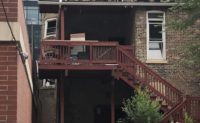Building officials of Miami-Dade County suspect deferred maintenance rather than weak building codes or an inadequate 40-year recertification process required by the county was the likely reason for the June 24 building failure in Surfside, Fla. The partial collapse of the 40-year-old Champlain Towers South residential condominium caused at least 98 fatalities.
The collapse of the 12-story condo is a tragic case that is “blowing everything out of proportion,” says Fredy Tain, structural division director in the Department of Regulatory and Economic Resources (RER) of Miami-Dade County.
Though the cause or causes of the Surfside debacle remain unknown, Jaime D. Gascon, director of RER’s board and code administration division, says that “at this time, there has been nothing identified as deficient in the building codes that would have caused” the failure.
Gascon thinks poor maintenance played a role in the tragedy. Building owners are required by regulation to maintain properties, but many defer maintenance because of costs and other factors, he says.
In the wake of the Champlain Towers South fiasco, building officials of the 35 jurisdictions in Miami-Dade County are collaborating on an initiative to review the recertification process to see if it can be improved, including whether the 40-year time frame is adequate. “We’re on a road to perfection,” says Tain.
“OVER THE YEARS A LOT OF FAILURES HAVE BEEN AVOIDED BECAUSE OF THE 40-YEAR RECERTIFICATION.”
— FREDY TAIN, MIAMI-DADE COUNTY STRUCTURAL DIVISION DIRECTOR
Miami-Dade County and neighboring Broward County are the only two places in the U.S. that require recertification, say Miami-Dade officials. Tain asserts the process works well. “Over the years, a lot of failures have been avoided because of the 40-year recertification,” he says.
Tain did not offer specific historic cases, explaining that would require a substantial research effort. But spurred by the June 24 tragedy, his division just completed a visual audit of the exteriors of 41 multifamily buildings, four stories or taller, in unincorporated Miami-Dade County, either undergoing or at the outset of recertification. The audit turned up no serious structural issues, except a deteriorated steel column supporting enclosed corner balconies of two four-story Royal Oaks condos. The problems were fixed the day after they were observed, says Tain.
In addition, during visual inspections of 62 multifamily buildings four stories or taller, made as a result of new recertification notices mailed at the beginning of July, RER did not find any issues that would have been cause for evacuation.
RER also is reviewing pending recertifications to ensure property owners are taking appropriate steps to correct deficiencies identified in the required engineers’ audits.
Debris Moved
At the collapse site, the remaining unstable wing of the structural-concrete building was imploded on July 4. As of July 21, debris and rubble had been moved from the site, to a warehouse or a lot elsewhere.
The National Institute of Standards and Technology (NIST), which is leading a probe of the collapse, reports having identified, marked and tagged electronically more than 200 concrete building elements, including pieces of columns, beams and slabs.
Before the site was cleared, remote sensing determined the location of pieces of evidence in the rubble. For this, investigators used light detection and ranging technology, known as LiDAR, that creates a type of digital map. Technicians took daily high- and low-resolution LiDAR scans of the site from balconies on adjacent buildings to the north and south. Time-lapse cameras also recorded the changing scene.
Working with the Rapid Response Research Facility of the National Science Foundation’s Natural Hazards Engineering Research Infrastructure Program, NIST has installed accelerometers to measure building vibrations and a seismometer to measure ground vibrations at the 12-story Champlain Towers North condominium, which is a near twin of the south tower. The data will be used to validate computer modeling of Champlain Towers South, says NIST, not to evaluate the condition of the north tower.
NIST also is in the process of assembling its National Construction Safety Act team that will lead the technical phase of the investigation. No names have been announced. “One of the conditions we have to consider before launching [a technical] investigation is if funds are available,” says Jennifer L. Huergo, a NIST spokesperson.
_ENRready.jpg?1627577887)





Post a comment to this article
Report Abusive Comment